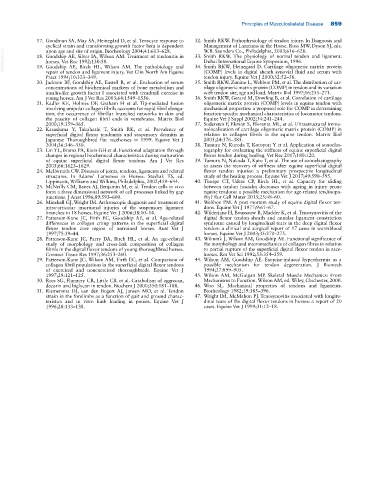Page 893 - Adams and Stashak's Lameness in Horses, 7th Edition
P. 893
Principles of Musculoskeletal Disease 859
17. Goodman SA, May SA, Heinegård D, et al. Tenocyte response to 32. Smith RKW. Pathophysiology of tendon injury. In Diagnosis and
cyclical strain and transforming growth factor beta is dependent Management of Lameness in the Horse. Ross MW, Dyson SJ, eds.
upon age and site of origin. Biorheology 2004;41:613–628.
W.B. Saunders Co., Philadelphia, 2003;616–628.
VetBooks.ir 18. Goodship AE, Silver IA, Wilson AM. Treatment of tendonitis in 33. Smith RKW. The physiology of normal tendon and ligament.
Dubai International Equine Symposium, 1996.
horses. Vet Rec 1992;130:58.
34. Smith RKW, Heinegard D. Cartilage oligomeric matrix protein
19. Goodship AE, Birch HL, Wilson AM. The pathobiology and
repair of tendon and ligament injury. Vet Clin North Am Equine
tendon injury. Equine Vet J 2000;32:52–58.
Pract 1994;10:323–349. (COMP) levels in digital sheath synovial fluid and serum with
20. Jackson BF, Goodship AE, Eastell R, et al. Evaluation of serum 35. Smith RKW, Zunino L, Webbon PM, et al. The distribution of car
concentrations of biochemical markers of bone metabolism and tilage oligomeric matrix protein (COMP) in tendon and its variation
insulin‐like growth factor I associated with treadmill exercise in with tendon site, age and load. Matrix Biol 1997;16:255–271.
young horses. Am J Vet Res 2003;64:1549–1556. 36. Smith RKW, Gerard M, Dowling B, et al. Correlation of cartilage
21. Kadler KE, Holmes DF, Graham H et al. Tip‐mediated fusion oligomeric matrix protein (COMP) levels in equine tendon with
involving unipolar collagen fibrils accounts for rapid fibril elonga mechanical properties: a proposed role for COMP in determining
tion, the occurrence of fibrillar branched networks in skin and function‐specific mechanical characteristics of locomotor tendons.
the paucity of collagen fibril ends in vertebrates. Matrix Biol Equine Vet J Suppl 2002;34:241–244.
2000;19:359–365. 37. Sodersten F, Ekman S, Eloranta ML, et al. Ultrastructural immu
22. Kasashima Y, Takahashi T, Smith RK, et al. Prevalence of nolocalization of cartilage oligomeric matrix protein (COMP) in
superficial digital flexor tendonitis and suspensory desmitis in relation to collagen fibrils in the equine tendon. Matrix Biol
Japanese Thoroughbred flat racehorses in 1999. Equine Vet J 2005;24:376–385.
2004;36:346–350. 38. Tamura N, Kuroda T, Kotoyori Y et al. Application of sonoelas
23. Lin YL, Brama PA, Kiers GH et al. Functional adaptation through tography for evaluating the stiffness of equine superficial digital
changes in regional biochemical characteristics during maturation flexor tendon during healing. Vet Rec 2017;180:120.
of equine superficial digital flexor tendons. Am J Vet Res 39. Tamura N, Nukada T, Kato T, et al. The use of sonoelastography
2005;66:1623–1629. to assess the recovery of stiffness after equine superficial digital
24. McIlwraith CW. Diseases of joints, tendons, ligaments and related flexor tendon injuries: a preliminary prospective longitudinal
structures. In Adams’ Lameness in Horses. Stashak TS, ed. study of the healing process. Equine Vet J 2017;49:590–595.
Lippincott, Williams and Wilkins, Philadelphia, 2002;459–644. 40. Thorpe CT, Udeze CP, Birch HL, et al. Capacity for sliding
25. McNeilly CM, Banes AJ, Benjamin M, et al. Tendon cells in vivo between tendon fascicles decreases with ageing in injury prone
form a three dimensional network of cell processes linked by gap equine tendons: a possible mechanism for age‐related tendinopa
junctions. J Anat 1996;89:593–600. thy? Eur Cell Mater 2013;25:48–60.
26. Minshall GJ, Wright IM. Arthroscopic diagnosis and treatment of 41. Webbon PM. A post mortem study of equine digital flexor ten
intra‐articular insertional injuries of the suspensory ligament dons. Equine Vet J 1977;9:61–67.
branches in 18 horses. Equine Vet J 2006;38:10–14. 42. Wilderjans H, Boussauw B, Madder K, et al. Tenosynovitis of the
27. Patterson‐Kane JC, Firth EC, Goodship AE, et al. Age‐related digital flexor tendon sheath and annular ligament constriction
differences in collagen crimp patterns in the superficial digital syndrome caused by longitudinal tears in the deep digital flexor
flexor tendon core region of untrained horses. Aust Vet J tendon: a clinical and surgical report of 17 cases in warmblood
1997;75:39–44. horses. Equine Vet J 2003;35:270–275.
28. Patterson‐Kane JC, Parry DA, Birch HL, et al. An age‐related 43. Wilmink J, Wilson AM, Goodship AE. Functional significance of
study of morphology and cross‐link composition of collagen the morphology and micromechanics of collagen fibres in relation
fibrils in the digital flexor tendons of young thoroughbred horses. to partial rupture of the superficial digital flexor tendon in race
Connect Tissue Res 1997;36:253–260. horses. Res Vet Sci 1992;53:354–359.
29. Patterson‐Kane JC, Wilson AM, Firth EC, et al. Comparison of 44. Wilson AM, Goodship AE. Exercise‐induced hyperthermia as a
collagen fibril populations in the superficial digital flexor tendons possible mechanism for tendon degeneration. J Biomech
of exercised and nonexercised thoroughbreds. Equine Vet J 1994;27:899–905.
1997;29:121–125. 45. Wilson AM, McGuigan MP. Skeletal Muscle Mechanics: From
30. Rees SG, Flannery CR, Little CB, et al. Catabolism of aggrecan, Mechanisms to Function. Wilson AM, ed. Wiley, Chichester, 2000.
decorin and biglycan in tendon. Biochem J 2000;350:181–188. 46. Woo SL. Mechanical properties of tendons and ligaments.
31. Riemersma DJ, van den Bogert AJ, Jansen MO, et al. Tendon Biorheology 1982;19:385–396.
strain in the forelimbs as a function of gait and ground charac 47. Wright IM, McMahon PJ. Tenosynovitis associated with longitu
teristics and in vitro limb loading in ponies. Equine Vet J dinal tears of the digital flexor tendons in horses: a report of 20
1996;28:133–138. cases. Equine Vet J 1999;31:12–18.

